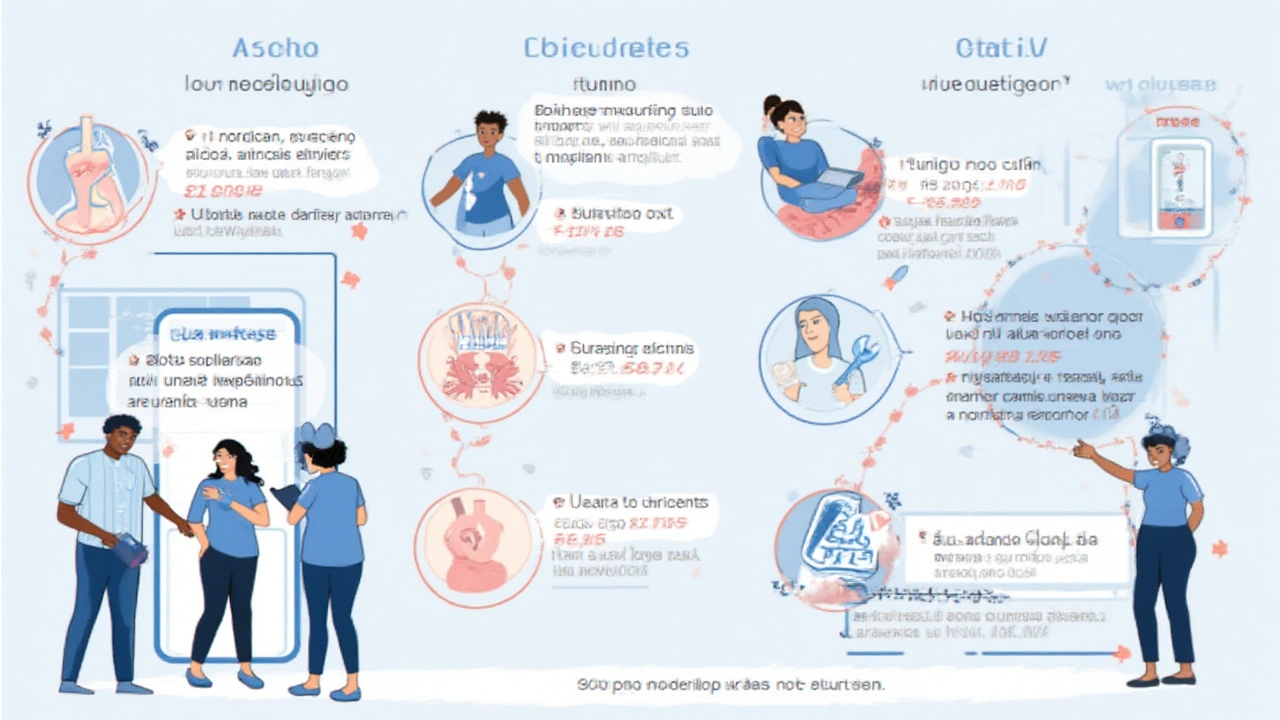
Health July 2, 2025
Forxiga: Uses, Benefits, Side Effects, and Real-World Tips
Imagine you could get better control over your blood sugar, shed a few pounds, and even protect your heart, all with a pill that many people haven’t heard about—yet it’s sitting in medicine cabinets around the globe. That’s Forxiga (dapagliflozin for science geeks), and it’s quietly changed lives since its approval, sparking curiosity and also a bit of confusion. You might have read bold claims about weight loss or horror stories about side effects online. But what’s hype, and what’s real? Here’s the honest, practical run-down you wish your doctor had time to give you.
What Is Forxiga and How Does It Actually Work?
It’s easy to dismiss another pill as “just another diabetes drug.” Forxiga isn’t your run-of-the-mill medication. It’s part of a newer class called SGLT2 inhibitors, which sounds like a robot name, but actually stands for “sodium-glucose cotransporter 2.” In plain English: it targets how your kidneys process sugar. Instead of letting all that extra glucose hang around in your blood (leading to all the not-fun diabetes symptoms), Forxiga tells your kidneys to pee it out. Literally. It means you may notice you’re in the bathroom a bit more, and, yes, your pee has sugar in it. Wild, right?
What’s unusual is that Forxiga doesn’t work by pumping up your insulin levels (which is what many older meds do). That’s why it doesn’t tend to cause hypoglycemia unless you take it with insulin or a sulfonylurea. The pill is taken once a day, usually in the morning. People often ask: will it burn out my kidneys? Research says no—if anything, recent studies suggest it may protect them. One 2023 review in the New England Journal of Medicine followed more than 17,000 adults and actually found less kidney damage in those using SGLT2 inhibitors like Forxiga. Think of it as helping your body stop recirculating sugar it doesn’t need.
But diabetes isn’t Forxiga’s only claim to fame. In recent years, researchers noticed people with type 2 diabetes weren’t just seeing better blood sugar—they had fewer heart attacks, and their hearts seemed less likely to fail. That led to trials using Forxiga in people with heart failure, even if they didn’t have diabetes. Surprise: it worked. The DAPA-HF trial (published in 2020) showed a 26% reduction in the risk of dying or being hospitalized for heart failure. That’s why, since 2022, Forxiga is approved across Europe and beyond for patients with heart failure regardless of whether they’re diabetic. So, this “sugar pill” is also a secret weapon for your heart.
How about non-diabetics with kidney disease? Yet again, Forxiga came through in trials, reducing serious kidney problems and helping patients avoid dialysis. It’s weirdly rare to find one drug with this many appeals, but that’s why doctors are excited and why you see it popping up more and more in pharmacies from Sydney to Stockholm.
Who Can Benefit from Forxiga?
Not every medical breakthrough is a one-size-fits-all solution, but Forxiga covers a surprising range. If you have type 2 diabetes, you’re in its main target zone. Studies consistently show HbA1c drops of 0.6–1.0 percentage points, which can be enough to switch people from “worrying” to “manageable” on their blood sugar charts. But unlike older meds, you often see bonus perks: modest weight loss (usually 2–3 kg after 6–12 months), lower blood pressure (by about 4–5 mmHg), and—you guessed it—protection for your heart and kidneys.
But maybe you don’t have diabetes. Forxiga is also approved for adults with chronic kidney disease (CKD), even if their sugar is fine, as long as they have certain markers like protein in their urine. That’s a meaningful option for folks who’ve spent years watching their kidney numbers slide, feeling a bit helpless. It’s even popping up in treatment plans for people with heart failure—specifically, those whose hearts can't pump blood as well as they should (what doctors call “reduced ejection fraction”). So, if you’re being tossed the word “heart failure” by your cardiologist, this little tablet might lower your odds of a hospital visit or even extend your life.
Here’s an interesting tidbit: while Forxiga is mainly prescribed to adults, there are ongoing studies investigating its effects in teenagers with type 2 diabetes. Early signs look hopeful, but doctors are (rightly) cautious for now. Pregnant women and those breastfeeding should steer clear—there are no reliable studies showing safety, so doctors don’t take the risk. People with type 1 diabetes? Not approved. In fact, using Forxiga here can tick up the chance of a dangerous condition known as diabetic ketoacidosis.
Wondering about older adults? Age alone isn’t a deal-breaker. What matters more is kidney function. Your doctor will order a blood test called eGFR, and as long as it’s above 25 mL/min/1.73m², Forxiga is usually fair game. If your kidneys are in really bad shape, though, the benefits fade and the risks go up.
Here’s a cheat sheet on who’s most likely to hear “Forxiga” during a doctor’s visit:
- Adults with type 2 diabetes (especially if other meds aren’t working, or if you want a pill with weight and heart perks)
- Anyone with chronic kidney disease (with or without diabetes, but with evidence of protein leak in the urine)
- People with heart failure with reduced ejection fraction (again, diabetes is optional here)
Doctors do routine check-ups for anyone on Forxiga, including blood and urine tests, to make sure kidneys and hearts are behaving as they should. If your results are stable, most folks can take it long-term (three years and counting is common in studies).

The Real-Life Benefits and Side Effects of Forxiga
Let’s get practical: what changes do real people actually notice? Most start feeling the impact within a week, with full benefits showing up after a month or two. You’ll probably spot extra bathroom trips (all that sugar has to exit somewhere), and weight can tick down by a few pounds after steady use. People used to carrying extra water weight or swelling (thanks, heart problems) say Forxiga often helps ease that bloated feeling. Blood sugar dips are often gentle—don’t expect wild swings unless you pair Forxiga with insulin or sulfonylureas, which can dip you too low.
The big wins: Forxiga has been shown to lower the risk of serious complications—like heart attacks, kidney failure, and hospitalizations for heart failure—in huge international studies. The DECLARE-TIMI 58 trial, with over 17,000 patients, saw heart-related hospitalizations drop by 27% among users compared to placebo. Weight loss statistics hover at 2–3 kg on average, but some people see more dramatic results, especially if paired with better diet and exercise.
But no pill is magic, right? There’s a catch with SGLT2 inhibitors: because they push sugar out through urine, yeast infections (especially in women) and urinary tract infections (UTIs) become more common. It’s not everyone, but enough that lovely cream and antifungal pills sit ready at most clinics. Dehydration is also something to watch for, especially in older adults—you have to drink a bit more water to keep up.
On the rarer side, some users develop a serious but unusual diabetic ketoacidosis (DKA), even if blood sugar levels don’t skyrocket—doctors call this “euglycemic” DKA. It’s more likely if you’re low-carb dieting, get sick, skip meals, or have type 1 diabetes (which is why it’s not approved here). Still, it’s not common: among 10,000 users, DKA affects about 1–2 each year. Stomach symptoms, deep tiredness, or rapid breathing? Call your doctor.
Here’s a breakdown of side effects from a large-scale clinical review published in The Lancet in May 2024:
| Side Effect | How Common (%) |
|---|---|
| Genital yeast infection | 5–10 |
| Urinary tract infection | 2–5 |
| Increased urination | 10–15 |
| Dehydration | 2–4 |
| DKA (in type 2 diabetes) | <0.2 |
| Serious kidney injury | <0.1 |
If you’re on blood pressure tablets (like ACE inhibitors), Forxiga can drop your pressure further. That’s a double-edged sword: good for some, but dizzying for others. Always keep your doctor looped in if you start feeling faint when you stand up.
There’s one reported, very rare side effect: Fournier’s gangrene (a nasty soft tissue infection around the genitals). It’s really rare—think a handful of cases in a million—but if you see redness, pain, or swelling in that area, especially with fever, don’t wait—get medical help, fast.
Everyday Tips for Taking Forxiga—and What Real Patients Say
Forxiga isn’t a “set it and forget it” pill—if you’re taking it, some small routine tweaks can make a not-so-small difference. First is hydration. Peeing out sugar draws water out of your body, so you’ll want to drink an extra glass or two through the day, especially if you’re out in the sun or exercising. Some people keep a water bottle with them and refill as needed, which seems basic but really helps prevent headaches and dizziness.
If you’re prone to yeast or urinary infections, wear loose, breathable underwear (cotton, not “sexy lace” as one patient joked to me), and avoid staying in wet gym clothes longer than needed. Early signs of an infection—like burning or itching—aren’t something to ignore. Most doctors prescribe a simple antifungal cream or tablet at the first hint, and staying ahead of symptoms usually avoids anything serious.
Timing the pill with breakfast can ease potential stomach upset. If you’re also on blood pressure meds, check if you’re feeling extra lightheaded when you stand. Sometimes the fix is as easy as splitting doses between morning and lunch, but always run any changes past your prescriber.
- Check your feet regularly (standard advice for diabetics, even more important here, since infections heal slower).
- If you get sick (vomiting, bad infection, fasting), skip Forxiga for a few days—this is the “sick day rule,” and it’s recommended everywhere from UK NHS to Australian TGA. Always ask your pharmacist or doctor for a quick “when to hold” cheat-sheet.
- Don’t panic if you see a bit more urine in the toilet—if you’re suddenly going every half hour or peeing out buckets, then call your doc.
- If you use a blood sugar meter, track your numbers daily for the first few weeks, then settle into a less frantic routine if things look good.
What do real patients say? A lot mention better energy and fewer spikes in blood sugar. Some say the lower appetite is a pleasant surprise—it’s not marketed as an appetite suppressant, but with pee sugar flying out, your body seems less interested in constant snacking. Others grumble about the bathroom trips, but most find it manageable if they go easy on salty, heavy foods.
If you’re worried about cost, good news: in Europe, Forxiga is typically covered by public health systems, and many insurers in the US offer decent copays (though not always). Ask your provider’s office to run a “prior authorization” if you hit a snag with your insurance—it can save you sleepless nights and a scary bill.
And don’t forget to celebrate your small wins: a drop in A1c, a two-pound weight dip, a stretch of months without a hospital visit. The people who feel best on Forxiga are the ones who stay engaged—checking numbers, asking questions, tiny habit tweaks. No pill replaces the power of paying attention to your own body.
Bottom line: whether you’re a newly-diagnosed diabetic, an old hand managing heart issues, or just someone wondering about new options, Forxiga deserves a closer look. Forxiga may not get splashy headlines, but it’s quietly making everyday lives a little healthier—and a bit more hopeful.
Write a comment
Items marked with * are required.






6 Comments
Agha Nugraha July 4, 2025 AT 23:20
Been on Forxiga for 8 months now. The bathroom trips are real, but honestly? Worth it. My A1c dropped from 8.1 to 6.9, and I lost 5 lbs without trying. No hypoglycemia episodes, which is huge for me. Also noticed my swelling went down-my shoes don’t feel like bricks anymore.
Andy Smith July 6, 2025 AT 21:05
As a primary care provider, I’ve prescribed Forxiga to over 40 patients in the last two years. The data is robust: HbA1c reduction, cardiovascular protection, and renal benefits are consistently replicated across trials. The most common issue? Patients underestimate hydration. I give everyone a 2-liter water bottle on day one. Also-yeast infections are treatable, not a reason to quit. Don’t panic; just call your pharmacy.
Rekha Tiwari July 6, 2025 AT 22:38
OMG YES 🙌 I was skeptical at first, but my doc put me on it for CKD and I didn’t even have diabetes! My protein levels dropped by half in 6 months. And yes, I go to the bathroom more… but I also feel lighter? Like my body isn’t holding onto all that extra junk anymore. Also, cotton underwear is now my best friend 😅
Leah Beazy July 8, 2025 AT 08:50
Just started this last month. First week was wild-peeing every hour. But now? I have more energy. No more 3 p.m. crashes. And I’m not craving sweets like before. My husband says I’m less grouchy. That’s a win. Also, I drink way more water now. It’s like my body finally got the memo to chill out.
John Villamayor July 10, 2025 AT 05:56
I'm from the Philippines and we don't have Forxiga here yet but my cousin in Canada is on it and she says it's life changing. No more swelling in her legs. She's 68 and was on insulin before. Now she just takes this one pill and feels better. I'm telling everyone about it
Jenna Hobbs July 10, 2025 AT 12:47
My mom had heart failure and wasn’t diabetic. When her cardiologist said ‘Forxiga,’ I thought it was a typo. Then I read the DAPA-HF trial results. She’s been on it for a year. No hospital visits. She walks the dog every morning. She cries when she talks about it. This isn’t just a drug-it’s a second chance. Thank you, science.